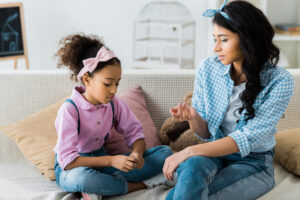As a child therapist (play therapist) who works with kids, I spend the first few therapy sessions with the child’s caretakers. We talk about the “grown up stuff” including what led them to seek therapy, their hopes for the future, and any questions they have for me. One of the most common questions I hear is this:
“What do I tell my child about coming to see you?”
The choice to bring your child to individual therapy (or family therapy) is often made after months or years of difficulty. Therapy may have been recommended by a friend or doctor. Perhaps you’ve been to therapy yourself and suspect it may benefit your child. But there is understandably a gap between knowing what you want and knowing how to present it to your child.
My response to this question is specific to play therapy. Because play therapy looks and sounds different from traditional talk based therapy, I will first spend some time explaining the basics of play therapy as a safe space for children.
I have found that parents feel most confident telling their child about therapy and bringing their child to sessions when they know what’s happening and why. After you read about play therapy 101 (for grown ups and kids!)I will jump into specific recommendations.
Play Therapy 101 (for grown ups):
Play therapy is an umbrella term used to describe a number of specialized and evidence-based therapy approaches traditionally geared towards children and adolescents. Most play therapists work under the belief that play is the vehicle through which children learn, develop, and heal. Play therapists do not teach people how to play. They use play to support a person’s cognitive, social, and emotional growth. Read our in-depth blog about Play Therapy here.
Play is not used to provoke conversation. In the words of writer and play therapy researcher Garry Landreth: “Toys are children’s words and play is their language” (Landreth, 2012). Just as adults go to therapy and talk about their challenges as a means of finding new ways to approach them, children do the same through play.
In the playroom, I reflect your child’s actions and emotions, set appropriate limits, and encourage their autonomy. When a child comes to the playroom, they are not “just playing”. They are doing the same work adults do in therapy through a medium that feels most natural to them: play!

Through play, I have watched children in therapy learn how to identify their emotions, regulate in response to overwhelming feelings, solve problems in new ways, increase their confidence, and improve their social skills. What better way to reach children than through the language they know and understand.
Play therapists have specialized training in communication skills, human development, working with children and families, and using play to encourage a child’s sense of autonomy and esteem.
Here is how I explain play therapy to kids:
Knowing that words aren’t the best way to reach kids, I keep my explanation brief. Here is what I usually say, based on the age of the child:
Play Therapy 101 for kids under 10 years old:
When you meet with me, you get to decide if you play, talk, or do both. Sometimes I will meet with your parents too.
Play Therapy 101 for Kids 11 and older:
When we meet, you can choose if you would like to play, talk, or do both. In therapy, you are in charge. What you talk about is confidential – meaning I do not share it with others. If you are being hurt, want to hurt yourself, or need more help, we will find ways to get you help from your parents or another adult.
You can choose to share what you do or talk about in therapy with the people in your world.
Sometimes I will meet with your parents to help them with parent stuff. It is important for parents to get help too.
Start with self reflection
Now that you have a taste of what play therapy is, let’s talk about how to translate it for children.
Before we jump to my recommendations, we’ll start with your experience. Think back to when you first heard about therapy. What images, feelings, or assumptions come to mind?

My first awareness of therapy began when I was 7 or 8. I learned my neighbor was a therapist that worked with incarcerated men. This neighbor had kids, a mustache, and rode a bike. To little me, therapy was something for men in jail and therapists were dads with mustaches who rode bikes. My developing brain only knew what I saw and heard. Without any additional information, that assumption stuck around until I saw and heard more.
Maybe you’ve been in therapy. And if you haven’t, you’ve likely had a lifetime of movie plots, news articles, and secondhand stories that have filtered to create your image of “therapy”.
Adult understanding of therapy is different from children. I have yet to meet an 8 year old who associates therapy with deep conversations and dark stuffy offices. I have yet to meet an adult who doesn’t have those same images in theirs. With that said, the message you communicate will form their foundation of what therapy is and why therapy is (or isn’t) helpful.
Part 2: Remember that you are the pilot of your child’s airplane
Imagine boarding a cross-country flight. You’re headed somewhere you really want to go. The pilot comes on the speaker and says “Hey, good luck being a passenger on this flight. Our plane is old and I’m not really sure how to fly it. Buckle up.” I suspect you may begin panicking or even get off the plane. The lack of confidence in the pilot’s message will undoubtedly influence how you feel and what you do.

While we cannot control how our children think or feel, we can certainly set the tone for new experiences through our words and behavior.
There is no need to be dishonest or create a false sense of confidence. Simply consider your message before sharing it.
Part 3: Answer these questions first:
- Why am I taking my child to therapy?
- How will I know they are feeling better?
Let’s say your kid is 8 and really having a hard time going to school. Here’s an example using the two questions above:
- Why I’m taking my kid to therapy…
- She is worrying and crying a lot, I feel exhausted trying to help
- We have tried ways to help the worry and nothing seems to work
- I know my kid is feeling better when…
- She is able to go to school without crying
- We know some new ways to help her when she’s worried
Now look at the notes you wrote down and imagine you are sharing that message with your child. Here are my notes after running them through the “how I want to communicate with kids” filter:
The message to a child:
You know how you have been worrying about school? You feel like crying a lot. Well how you feel is so important. I know someone who can help you and our family learn how to take care of our feelings.
Keep in mind: kids are not rational beings. Their default is emotion, not logic. Be cautious about giving wordy explanations as this tends to confuse kids. If we could reason our way through parenting, we would have done it by now!
Instead, focus on delivering a message that is concise and supportive. Include yourself as part of the process. We know kids get the most from therapy when their parents are actively involved* in their treatment.
Above all, remember that there is no perfect way to present therapy. What’s important is that you describe therapy as a positive and meaningful opportunity for you and your child.
*Parent involvement typically looks like bringing your child to sessions and regularly meeting with the therapist to monitor your child’s response to treatment.
A note of caution: If you present therapy as a consequence of bad behavior, your child will see it as a punishment. If you single your child out as the reason for the family’s stress, your child will likely be resistant to treatment. If you insist your child talks in therapy or shares recent challenges, their sense of control goes out the window. No one likes being told what to do, think, or feel. Especially children. What children want to know is that they will have a space to play or talk as they choose. When given time, tools, and opportunity, children will learn better ways of relating to their world.
Blog written by Sentier Therapist, Lily Ferreira, MSW, LICSW











